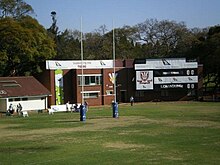This article needs additional citations for verification .(August 2009) |
| Prince Edward School | |
|---|---|
 Prince Edward School Badge | |
| Location | |
 | |
| Coordinates | 17°49′14″S31°02′06″E / 17.8205°S 31.0350°E |
| Information | |
| Type | State school, boarding and day school |
| Motto | Tot Facienda Parum Factum (Latin: So much to do, So little done) |
| Established | 13 June 1898 [1] |
| Headmaster | Dr. Aggrippa G. Sora [2] |
| Gender | Boys |
| Age | 13to 19 |
| Number of students | 1200+ |
| Education system | Zimbabwean |
| Houses |
|
| Colour(s) | Maroon, green and white |
| Mascot | Tiger |
| Nickname | PES |
| Rival | St George's College, Harare |
| Newspaper | The Hararian |
| Alumni | Old Hararians |
| Postal address | P.O. Box CY418, Causeway Harare Zimbabwe |
| Badges | The Three Feathers |
| Website | www |
Prince Edward School (or Prince Edward, commonly referred to as PE) is a public, boarding and day school for boys aged 13 to 19 in Harare, Zimbabwe. It provides education facilities to 1200+ boys in Forms I to VI. The school is served by a graduate staff of over 100 teachers.
Contents
Prince Edward School was ranked 6th out of the top 100 best high schools in Africa by Africa Almanac in 2003, based upon quality of education, student engagement, strength and activities of alumni, school profile, internet and news visibility. [3] Prince Edward School was also ranked as one of the Top 10 High Schools in Zimbabwe in 2014. [4]
